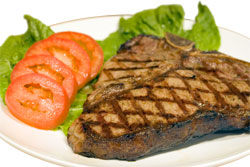- Eating and snacking patterns
- Potential nutrition-related problems for adolescent children
- High-risk adolescent groups
- Healthy eating tips for adolescents
Introduction to nutrition in adolescent girls
Adolescence is the transition period between childhood and adulthood, a window of opportunity for the improvement of nutritional status and correcting poor nutritional practices. This is about the same period puberty sets in, typically between the ages of 10 and 13 years in girls. Adolescence is characterised by the growth spurt, a period in which growth is very fast. During this time, physical changes affect the body’s nutritional needs, while changes in one’s lifestyle may affect eating habits and food choices. Adolescent nutrition is therefore important for supporting the physical growth of the body and for preventing future health problems. All parents should therefore pay particular attention to the nutritional needs of their teenagers.
Why nutrition is essential for adolescent girls
Any nutritional deficiency experienced during this critical period of life can have an effect on the future health of the individual and their offspring. For example, failure to consume an adequate diet at this time can result in delayed sexual maturation and delayed or retarded physical growth. The rapid physical changes of adolescence have a direct influence on a person’s nutritional needs. The growth spurt that occurs in adolescence, second only to that in the first year of life, creates increased demands for energy and nutrients. Nutritional status and physical growth are dependent on one another such that optimal nutrition is a requisite for achieving full growth potential.
Nutrition of the adolescent girl is particularly important but under-nutrition (too little food or food lacking required nutrients) in adolescents frequently goes unnoticed by their families or the young people themselves. Adolescence is a time to prepare for the nutritional demands of pregnancy and lactation that girls may experience in later life. Under-nutrition negatively affects adolescent girls by:
- Affecting their ability to learn and work at maximum productivity;
- Increasing the risk of poor obstetric outcomes for teen mothers;
- Arresting the healthy development of future children;
- Affecting sexual maturation and growth: and
- Preventing the attainment of normal bone strength and the development of healthy teeth if a youth doesn’t get enough calcium.
It is also a well established fact that children born to short, thin women are more likely themselves to be stunted and underweight (low weight for age). What is more worrying therefore is that the negative effects of adolescent malnutrition persist throughout a woman’s reproductive life. Dietary reference intakes (DRIs) developed by the National Health and Medical Research Council of Australia (NHMRC) provide current quantitative estimates of nutrient intakes to be used for planning and assessing diets for healthy people, including adolescents. The important nutrients that need to increase during adolescence include energy, protein, calcium, and iron.

During adolescence, dietary fat continues to play important roles as an energy source, a significant cell structural component, a precursor to agents of metabolic function and a potent gene regulator. The Australian dietary guidelines for children and adolescents recommend 25% of total energy as fat, with less than 10% of energy from saturated fat for children aged over 15 years. The type of fat rather than its quantity is more important in determining the health consequences of dietary fat. This is because studies have shown that eating a low-fat diet for 8 years did not prevent heart disease, breast cancer, or colon cancer, and didn’t do much for weight loss, either. Effective strategies for reducing fat intake in children include the use of skim milk and choosing only lean meat. A positive association between dietary saturated fats and total cholesterol level has demonstrated in an Australian adolescent population, although dietary factors may be more important in girls.
Protein needs of adolescents are determined by the amount of protein required for maintenance of existing lean body mass and the development of additional lean body mass during the adolescent growth spurt. In effect, protein is important for growth and maintenance of muscle. Adolescents need between 45 and 60 grams of protein each day. Most teens easily meet this requirement with their intake of beef, chicken, eggs, and dairy products. Protein is also available from certain vegetable sources, including tofu and other soy foods, beans, and nuts. These foods should be included in the diets of vegetarians especially. When protein intakes are consistently inadequate, reductions in linear growth, delays in sexual maturation and reduced accumulation of lean body mass may occur.
It is estimated 45% of peak bone mass is attained during adolescence and so adequate calcium intake is important for the development of dense bone mass and the reduction of the lifetime risk of fractures and osteoporosis. Additionally, calcium needs during adolescence are greater than they are in either childhood or adulthood because of the increased demand for skeletal growth. Adequate calcium intake is essential also for development of strong and dense bones during the adolescent growth spurt. Inadequate calcium intake during adolescence and young adulthood puts individuals at risk for developing osteoporosis later in life. In order to get the required 1,200 milligrams of calcium, teens are encouraged to consume three to four servings of calcium-rich foods each day. Milk provides the greatest amount of calcium in the diets of adolescents, followed by cheese, ice cream and frozen yogurt.
Girls preoccupied with body shape might have a dilemma of including calcium-rich dairy foods, which they perceive as fattening. The National Nutrition Survey carried out in 1995 found 56 per cent of Australian girls aged 9 to 13 years did not meet the recommended dietary intake for calcium.
The fear of getting fat through the consumption of dairy foods appears to be premature and may therefore not be a critical determinant of obesity since a recent study conducted in Canada found no difference in changes in per cent body fat over two years between girls eating varying amounts of calcium from food. Indeed, the type of fat consumed and not the quantity of fat per se must be watched.
Empirical evidence indicates that bad fats, meaning saturated and trans fats, increase the risk for certain diseases while good fats (that is, monounsaturated and polyunsaturated fats), lower the risk. The basic idea regarding the prevention of diseases associated with fat consumption is to substitute good fats for bad fats. (Read more on how to reduce cholesterol in Nutrition for Lowering Cholesterol Levels)
There also appears to be varying degrees to which individuals respond to dietary fat intake. Calcium-fortified foods including orange juice, breakfast bars, bread and cereals are excellent sources of calcium. A study in the US showed that adolescents in the highest soft drink consumption category were found to consume less calcium and vitamin C than non-soft drink consumers. Therefore, excessive soft drink consumption by adolescents may displace the consumption of more nutrient-dense beverages, such as milk and juices. Good sources of calcium include milk, yogurt, cheese, calcium-fortified juices, and calcium-fortified cereals.

Zinc is important in adolescence because of its role in growth and sexual maturation. It is known that serum zinc levels decline in response to the rapid growth and hormonal changes that occur during adolescence. Serum zinc levels indicative of mild zinc deficiency (<10.71 x10-6 mol/L) have been found in 18% to 33% of female adolescents. The RDA for zinc for males and females ages 9-13 is 8 mg/day. For females ages 14-18, the RDA 9 mg/day. Zinc is naturally abundant in red meats, shellfish, and whole grains. Additionally, many breakfast cereals are fortified with zinc. Zinc and iron compete for absorption, so elevated intakes of one can reduce the absorption of the other. Adolescents who take iron supplements may be at increased risk of developing mild zinc deficiency if iron intake is over twice as high as that of zinc.
Folate plays an integral role in DNA, RNA and protein synthesis. Thus, adolescents have increased requirements for folate during puberty. Rich sources of dietary folate consumed by adolescents include ready-to-eat cereal, orange juice, bread, milk, and dried beans or lentils. Adolescents who have formed the habit of skipping breakfast or do not include orange juice and ready-to-eat cereals in their meals may be at an increased risk of low folate consumption.
Book your health appointments online
Find and instantly book your next health appointment with Healthengine
Eating and snacking patterns
Adolescents tend to eat differently than they did as children. Preoccupied with after-school activities and engagement in active social endeavours, adolescents are not always able to sit down for three meals a day. These apparent busy schedules may lead to meal skipping, snacking throughout the day, and more eating away from home. Many teens skip breakfast, for example, but this meal is particularly important for getting enough energy to make it through the day, and it may even lead to better academic performance. When teens skipping meals at home is prevalent, the likelihood of purchasing fast food from a restaurant, vending machine, or convenience store will be high. These foods tend to be high in fat and sugar and they provide little nutritional value. More importantly, eating too many fast foods can lead to weight gain and which may predispose one to diseases such as diabetes and heart disease.
Potential nutrition-related problems for adolescent children
Poor eating habits during the critical adolescent years may lead to both short and long term health consequences including obesity, osteoporosis, and sexual maturation delays. Adolescents are at risk of obesity, obesity-related chronic diseases, and eating disorders.
All over the world, adolescent obesity is on the rise. In Australia, the prevalence of overweight and obesity is reported to be on the increase among children and adolescents, suggesting a problem with energy imbalance. Obesity is associated with an increased risk of obesity-related diseases like diabetes and heart disease. Experts have linked this rise in obesity to lack of physical activity and an increase in the amount of fast food and “junk food” available to adolescents. Staying active and avoiding sugary drinks and fatty snacks foods will promote a healthy weight for adolescents.
Over-eating, under-eating and eating disorders can have serious health impacts. Adolescents tend to be very conscious of appearances and may feel pressured to be thin or to look a certain way (that is self image). Fear of becoming obese may lead to overly restrictive eating habits. Some adolescents even go to the extent of resorting to self-induced vomiting in an attempt to control their weight.
High-risk adolescent groups

When a teenager becomes pregnant, she needs more nutrients than her non-pregnant colleague to support both her baby and her own continued growth and physical development. If her nutritional needs are not met, her baby may be born with impaired foetal growth and the subsequent low birth weight or other health problems. For the best outcome, pregnant adolescents need to seek prenatal care and nutrition advice early in their pregnancy (see Nutrition During Pregnancy for more information).
Adolescents involved in athletics may feel pressure to be at a particular weight or to perform at a certain level. Some young athletes may be tempted to adopt unhealthy behaviours such as crash dieting, taking supplements to improve performance, or eating unhealthy foods to fulfil their hearty appetites. A balanced nutritional outlook is important for good health and athletic performance.
A vegetarian diet can be a very healthy option. However, adolescents who follow a vegetarian diet, whether for religious or personal reasons, need to carefully plan their intake to get the protein and minerals they need. Strict vegetarians (those who do not eat eggs or dairy products), also known as vegans, may need nutritional supplements to meet their needs for calcium, vitamin B12, and iron.
Healthy eating tips for adolescents
Consume low-fat foods especially include sources of polyunsaturated and monounsaturated fatty acids (oils, lean meat, poultry and nuts) but limit intake of “hidden” saturated fatty acids (for example, biscuits and fast foods).
More information
 |
For more information on nutrition, including information on types and composition of food, nutrition and people, conditions related to nutrition, and diets and recipes, as well as some useful videos and tools, see Nutrition. |
References
- Story M. Nutritional requirements during adolescence. In: McAnarney ER, Kreipe RE, Orr DE, Comerci GD, eds. Textbook of adolescent medicine. Philadelphia: WB Saunders, 1992: 75-84.
- National Health and Medical Research Council. Nutrient Reference Values for Australia and New Zealand including Recommended Dietary Intakes. Canberra: NHRMC, 2006.
- Storlien LH, Tapsell LC, Fraser A. Insulin resistance: influence of diet and physical activity. World Rev Nutr Diet 2001;90:26-43.
- National Health and Medical Research Council. Draft dietary guidelines for children and adolescents: www.health.gov.au/hfs/nhmrc/advice/diet.htm, 2001.
- Beresford SA, Johnson KC, Ritenbaugh C, et al. Low-fat dietary pattern and risk of colorectal cancer: the Women’s Health Initiative Randomized Controlled Dietary Modification Trial. JAMA 2006;295:643-54.
- Howard BV, Manson JE, Stefanick ML, et al. Low-fat dietary pattern and weight change over 7 years: the Women’s Health Initiative Dietary Modification Trial. JAMA 2006;295:39-49.
- Howard BV, Van Horn L, Hsia J, et al. Low-fat dietary pattern and risk of cardiovascular disease: the Women’s Health Initiative Randomized Controlled Dietary Modification Trial. JAMA 2006;295:655-66.
- Peterson S, Sigman-Grant M. Impact of adopting lower-fat food choices on nutrient intake of American children. Pediatrics 1997:100.
- Gliksman MD, Lazarus R, Wilson A. Differences in serum lipids in Australian children: is diet responsible? Int J Epidemiol 1993;22:247-254.
- American Academy of Pediatrics, Committee on Nutrition. Calcium requirements of infants, children, and adolescents. Pediatrics 1999;104(5):1152-1157.
- Subar AF, Krebs-Smith SM, Cook A, Kahle LL. Dietary sources of nutrients among US children, 1989- 1991. Pediatrics 1998;102(4):913-923.
- Australian Bureau of Statistics. National Nutrition Survey. Canberra: Commonwealth Department of Health and Aged Care, 1995.
- Barr SI. Calcium and body fat in peripubertal girls: cross-sectional and longitudinal observations. Obesity 2007;15:1302-10.
- Harnack L, Stang J, Story M. Soft drink consumption among US children and adolescents: nutritional consequences. J Am Diet Assoc 1999;99 (4):436-441.
- Donovan UM, Gibson RS. Iron and zinc status of young women aged 14 to 19 years consuming vegetarian and omnivorous diets. J Am Coll Nutr 1995;14 (5):463-472.
- Zaimin W, Patterson CM, Hills Andrew P. The relationship between BMI and intake of energy and fat in Australian youth: a secondary analysis of the National Nutrition Survey 1995. Journal of the Dieticians Association of Australia 2003.
All content and media on the HealthEngine Blog is created and published online for informational purposes only. It is not intended to be a substitute for professional medical advice and should not be relied on as health or personal advice. Always seek the guidance of your doctor or other qualified health professional with any questions you may have regarding your health or a medical condition. Never disregard the advice of a medical professional, or delay in seeking it because of something you have read on this Website. If you think you may have a medical emergency, call your doctor, go to the nearest hospital emergency department, or call the emergency services immediately.








